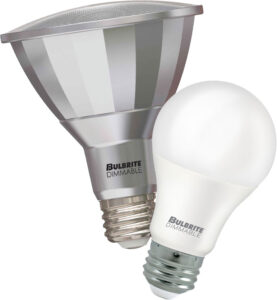LEDs vs. OLEDs: What’s the Difference?
What Is LED?
 In technical terms, a light-emitting diode is a semiconductor that emits light when a voltage is applied. To the typical person, LED bulbs and light fixtures are an energy-efficient option that can help lower electricity bills and cut back on bulb replacements. On average, an LED bulb can last 25,000 hours versus an incandescent bulb, which only lasts a mere 1,500 hours.
In technical terms, a light-emitting diode is a semiconductor that emits light when a voltage is applied. To the typical person, LED bulbs and light fixtures are an energy-efficient option that can help lower electricity bills and cut back on bulb replacements. On average, an LED bulb can last 25,000 hours versus an incandescent bulb, which only lasts a mere 1,500 hours.
When these bulbs began to grow in popularity, many home and businessowners were turned off by their “blue” tint. With today’s technology, LED light is softer, making it a great source of general illumination in living and office spaces.
What Is OLED?
Much like our devices – phones, laptops and tablets – have gotten smaller or slimmer, OLEDs are essentially thinner LEDs with an alternative way to emit light versus a semiconductor. What other differences exist?
- Traditional LEDs are coated with yellow phosphor, whereas OLEDs use organic compounds.
- Organic LEDs are even more environmentally friendly than LEDs because they lack UV rays.
- OLEDs have a color rendering index (CRI) of 90 or greater, in line with natural sunlight.
- An OLED bulb also produces less heat than a traditional LED bulb.
- Given the paper-thin construction of OLED panels, their shape can be altered with ease.
OLED lights are certainly an interesting concept, but they are still in the beginning stages of development for a big market push.
Downsides of OLEDs
Currently, LED lamps have a higher brightness and lumen lifespan. If OLED fixtures are unable to provide general illumination, the worth of their investment comes into question. As organic LEDs become more desirable in design for their flexibility, they also come with a high price tag. A panel can cost $200 before it has been transformed into a light!
When you visit our Hartford or Southington showroom, our lighting experts can explain to you why all LEDs are not created equal. Discover how you could save money on your energy bills today!
